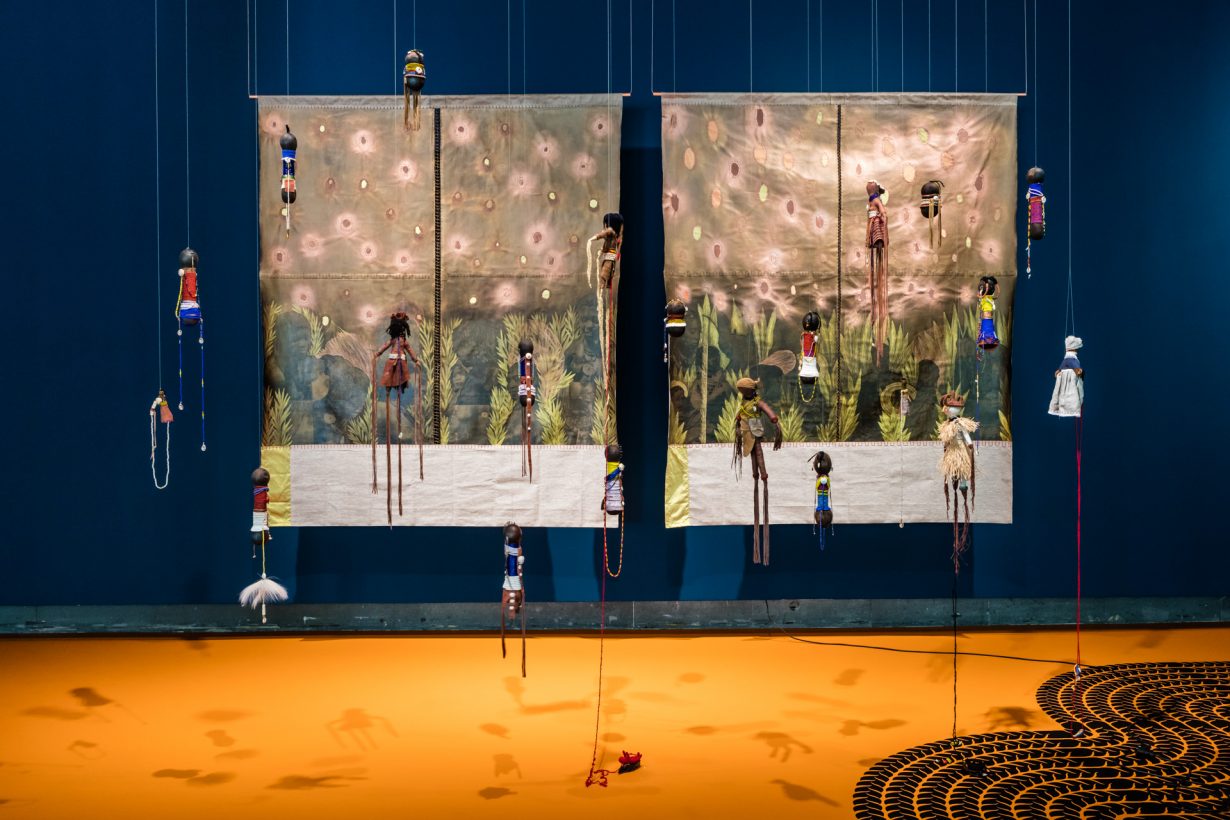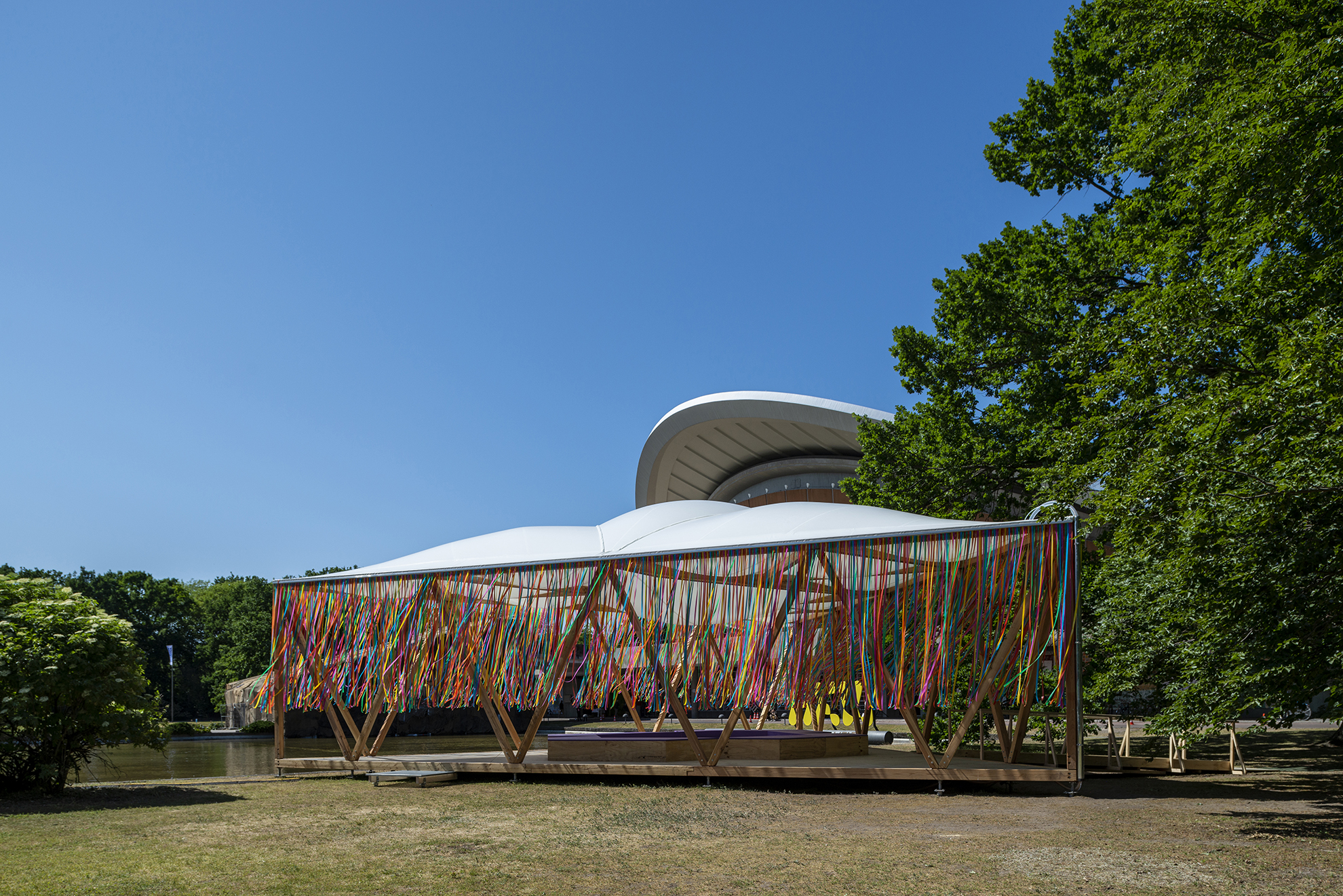O Quilombismo at Haus der Kulturen der Welt argues that radical change can only happen by making space for other perspectives within the dominant culture
It is difficult to think about O Quilombismo without considering the broader reimagining of Haus der Kulturen der Welt, now under the direction of Bonaventure Soh Bejeng Ndikung, the Cameroonian curator and founder of Berlin’s Savvy Contemporary. The exhibition’s subtitle heralds a clear break in the institution’s history: the leadership and curatorial staff have changed, the institution has a new brand identity and website, its spaces have been named to highlight the legacy of influential but neglected women of colour and the walls have been repainted in bright colours like magenta, teal and acid-green. Pulling against HKW’s Western modernist image was always going to be a challenge, but this is certainly a determined start.
O Quilombismo is a rich and compelling exhibition, with an extensive programme of accompanying performances, workshops and events, many of which took place over its jubilant opening weekend. What remains now are the works – many newly commissioned – of more than 70 artists, shown throughout the iconic building and its grounds. Guiding the exhibition is Brazilian Pan-African thinker Abdias Nascimento’s theory of quilombismo, a political philosophy based on the quilombo, a community of escaped slaves. For Nascimento, the quilombo marked a tear in colonial power, a joyful, egalitarian society founded on refusal and escape. In this spirit, O Quilombismo emphasises the contributions of artists and communities, especially Indigenous peoples, in the main ignored by the traditional (Western) artworld.
Approaching HWK from alongside the Spree, I first notice three flags in black, red, yellow and green bearing the letters ‘DDR’, mounted high on the upstairs terrace. A new commission from Nigerian-born American artist and poet Olu Oguibe, DDR: Decarbonize, Decolonize, Rehabilitate (2022) compresses Pan-African, Australian Aboriginal and German flags, highlighting the colonialist foundation of German nationhood as well as the need for reparation. Moving around to the front of the building, a mural by the Brazilian artist Alberto Pitta celebrates the country’s Afro-diasporic culture, while In the Garden (2023), one of two works by Ibrahim Mahama, covers and obscures a portion of the building’s architecture in decayed fabrics, handwoven together with traditional West African techniques.

In the ground-floor Sylvia Wynter Foyer, Amina Agueznay follows a similar path, wrapping six of the building’s thick columns in webs of yarn, made in collaboration with traditional craftspeople of her homeland, Morocco. Up above, an enigmatic nine-part mural by the Cameroonian artist Tanka Fonta is arranged in a circle, like an abstract cosmological epic. In the middle of the space, UK artist Barby Asante’s video installation Declaration of Independence (2017–) plays on three screens surrounded by two stone circles; here, we witness the weary but resolute testimony of women of colour (‘delegates’) in a white world. Parodying the structure of UN or corporate summits, during which people of colour are often tokenistically platformed, it’s a powerful vision of refusal, self-organisation and collective healing.
In the largest space, the ground-floor Mrinalini Mukherjee Hall, sculptural works take precedence – rising like knots from Nontsikelelo Mutiti’s intricate, braidlike floor mural (Kubatana (togetherness / unity / connecting / touching / holding), 2023); hanging from the ceiling; fixed to the walls. Recurring throughout, however, is an expanded, performative idea of art as something with ritualistic or spiritual purpose. This spans Big Chief Demond Melancon’s feather-and-bead costumes marking the entangled histories of African and Native American cultures (Bras-coupé (Vest and Dickie), 2016; Africa, 2011; Red Cloud & Sitting Bull, 2013), Bernardo Oyarzún’s parade-float depiction of Piwuchen, the mythological shapeshifter of Mapuche Indigenous culture of Chile and Argentina (Kilombo: Piwuchen, 2023), and the delicate and uncanny fertility dolls of Tuli Mekondjo (Ounona vedu (Children of the Soil), 2023). These artworks are agents of wider, and likely much more meaningful processes that have only ever happened elsewhere.

Following a halting accordion refrain spilling out from an overlooking space, we find Assaf Gruber’s Never Come Back (2022), a video installation featuring a naked accordionist, the instrument’s black leather straps taut against his skin, as he tracks around the storage rooms of Graz’s Neue Galerie. Looking for inspiration, titillation or both, he plays in response to a series of banal, seemingly traditional paintings, before moving on to the next. Placing ‘traditional’ art alongside a clear intimation of sadomasochism, and with the accordion tune’s frenzied lyrics – Desireless’s 1986 Europop hit Voyage, Voyage – spelled out in Fraktur, a typeface style associated with Nazism, the work denaturalises tradition to bind viewing and creativity with colonial domination and violence.
Across the foyer in the Beatriz Nascimento Hall, the work is smaller and more intimate. Featured heavily are the coded paintings of Abdias Nascimento, which set the symbolism of the Afro-Brazilian Candomblé religion against the totalising logic of Western modernism. Elsewhere, Maria Auxiliadora’s effervescent, meticulous canvases capture the festive conviviality of Afro-Brazilian working-class life. Elsewhere, in the fantastical short film Ngura Pukulpa – Happy Place (2021), Yankunytjatjara artist Kaylene Whiskey is a campy icon of the bush, flying over her ancestral homeland, dancing and singing with her compatriots. These depictions get to the heart of quilombismo, as an anti-imperialist struggle founded on collectivity and joy.
Of course, the quilombo is both a real place and a utopia; as many have pointed out, the largest of them, Palmares, was not especially egalitarian but instead organised by strict kinship structures. What this exhibition and quilombismo itself seem to imply, however, is that radical change can only happen by making space for other perspectives within the dominant culture. This is hard to disagree with. Still, it remains to be seen whether that space is there within the traditional artworld – no amount of brightly coloured paint, after all, will free HKW from the conventions, and baggage, of the Western museum. What happens to these perspectives here? Do they lose something? All I can say for certain is that they enrich HKW.
O Quilombismo: Of Resisting and Insisting. Of Flight as Fight. Of Other Democratic Egalitarian Political Philosophies at Haus der Kulturen der Welt, Berlin, through 16 September
